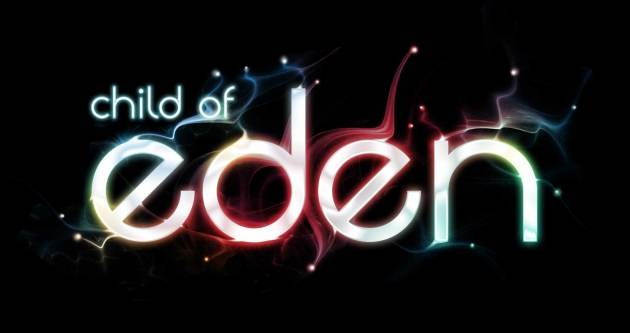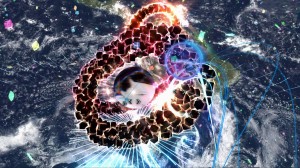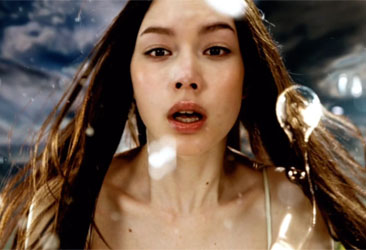
“Videogames are art!” yells the black-suited Ubisoft exec as he peddles out the latest swirling digital eyesore. 3D primitives dance across a glitch-driven psycho-seizure background as you scramble over the buttons rapidly, hoping that you’re somehow winning. Thousands of purple bolts fly toward you, unavoidable, draining your energy completely. Having fun yet? Why should that matter? It’s art! ART!
Child of Eden is what I’ve always wanted, per sarcasm. There are moments when this game constitutes nothing more than Connect the Dots in glorious high-definition, while some of my favorite songs by the Genki Rockets are slaughtered in the background. It’s basically just the long-awaited sequel to Rez. Once you strip the whole product down to the core, the elements inside are very weak and do not sustain you.
I’m not attacking either game, though (truth be told I’m up for a spot of Rez every six months or so); I’m just not sure how to even go about reviewing this kind of game. For starters, it’s not exactly an easy game to describe, but I will try regardless.

The main focus of this “experience” is to rescue Lumi from Eden, a computer system overrun by some kind of virus. Sound familiar? Yes, the overall premise of both Child of Eden and Rez are the same, bar the inclusion of Lumi, the avatar of the Genki Rockets.
In this story, Lumi is a woman who was born on the International Space Station and never ever went to Earth, the same story that is associated with the Genki Rockets.
Lumi’s memories were stored, and now she’s been recreated as a digital avatar inside Eden, the 22nd Century equivalent of the Internet. However, something bad has happened inside Eden, and now both Lumi and Eden are in danger. I’m not really sure who you are, or why you’re there, but you’re definitely the only person who can put right this strange situation.
I make it sound vague, but this isn’t for lack of background story—there’s too much, and the game slowly reads it to you when you start playing. After this block of text, a rather visually pleasing opening video of Lumi does little else than remind me that I find most Japanese women sexually attractive.
 Rescue Lumi. Save Eden. Boner Get.
Rescue Lumi. Save Eden. Boner Get.
After the full-motion video is over, the game begins and you are thrown into the deep end of the proverbial arty-farty swimming pool. Well, more like a pulsating kaleidoscope, with panels on the left- and right-hand sides. Your experience will be completely interrupted by tutorials, so you’ll work out the basics soon enough.
Orange enemies are defeated by using the “Tracker,” which is initiated using the A button or by raising your right hand when playing with the Kinect hardware. This highlights up to ten enemies at once, and can then be detonated for a large score bonus. The other weapon is the “Tracer,” which is your straightforward rapid-fire weapon. This is used to dispatch purple enemies, and also to destroy enemy bullets.
Whilst firing the Tracer, a rather satisfying drum-beat is overlapped onto the in-game audio. It’s a nice touch. When playing with the Kinect plugged up, you feel like you’re commanding the audio, though you don’t really have any control over it.
Each stage is based on this pattern: One or more objects fly in. If the object is orange, use Tracker. If the object is purple, use Tracer. If you use Tracer and the object turns orange, switch to Tracker. If enemies are shooting bullets, destroy them with Tracer. If the boss is obscured by blocks, use Tracer to shoot them away and then use Tracker on the boss.
There are also bombs you can collect, which are called Euphoria. Using Euphoria will destroy all enemies on the screen. It sounds useful, but you’d much rather have the score bonus at the end of each level for not using them.
Each stage ends with a boss battle, which results in the “decryption” of each game area. There are six in total, and when they’re all all decrypted, the game is over. Don’t worry though, you can’t just breeze through it! No, you have to replay old levels until you have enough stars to progress. The levels are just a smidgen too bloody long, and replaying them actually does drag on a widdle bit.
When you’ve wasted a few hours, you may reach the finale, which left me confused: I defeated the final and brutally difficult boss battle, but instead of being welcomed by the credits, I was shown a large tree across a white background. Leaves were glistening with white orbs. Using Tracker on these orbs caused them to explode and leave behind photographs. Seeing as I have come this far, without question I just blast these orbs with Tracker until the game is officially beaten.

Then I receive a 100G Achievement and the credits roll. So that’s the ending to Child of Eden. Great, I don’t have to play it anymore. What’s with the whole big tree thing? Did I miss the point, or is Tetsuya Mizuguchi doing his usual thing of developing games that have absolutely no story substance? I think it’s the latter.
Don’t get me wrong, this is an “experience” you would want to put yourself through at least once, but unless you can play this kind of game for hours, I’m not sure you’ll get much mileage out of it. As for the Kinect controls, they just result in dead arms for a few days as you can barely play the game anymore. Holding your arms out for a twenty-minute level can have adverse effects on your ability to pick things up.
There are better ways to spend your dollars, but I feel like I have to respect Child of Eden for its creative direction and almost pinpoint precision in its execution. Fans of Rez should jump onto this as soon as possible. As for ordinary folk, download the demo and see if you can understand it.
For more oddness from lovable whack-job Tetsuya Mizuguchi, see Zach Rich’s review of Rez HD.


I didn’t like this game much although this Lumi girl looks hot !
This just looks bizarre, but some of the finest games out there are the ones that make no sense.